|
Lunae
Tuning
by Ron Gerbron
from
RongTolas Website
The Man in the Moon; the
God/Goddess/Demon/Hare in the Moon; the Shield of Somebody
Important-Moon. The Moon has a Face, it is Watching us. That last
may or may not strike you as a comforting thought. There are lots of
permutations, too, but the basic Adamic urge to Put a Name with
the (Moon) Face is found in all cultures. It is difficult not to
notice it. Also, the close and obvious connection between lunar
cycles and plant cycles made the Moon a participant in
early agricultural societies, as if it had a will of its own (or a
driver) and rated a name. Of course, as soon as you join a new
group, the gossip starts... The Moon has built up quite a rap sheet.
Some
Native American traditions
speak of a time before Earth acquired its present Moon, of a time
when Earth had two smaller moons. We won’t detour there right now-
details and interpretations galore are available at a website near
you, or bookstores everywhere. However, sticking to the subject of
the Moon we have now, let us ponder that “acquired” thing. We shall
begin with the theories put forth way back in 1976 in a most unusual
book, Somebody Else Is On The Moon, by George H.
Leonard.
His conclusions were fantastic, even outrageous, but all referenced
point by point with quotes from NASA personnel and
various experts in geology, astronomy, and other scientific fields.
He had a group of students work with him on the visual analysis of
lunar photographs, and his book is full of sketches detailing the
things he found. That is where I will diverge from his perspective.
I agree with most of the conclusions he reached, but for different
reasons.
Leonard started with the basic mysteries of the Moon.
Like, where did it come from? It is too large, relative to the mass
of the Earth, to have been gravitationally captured. If it was a
wandering body that strayed near the Earth, it would have been drawn
right into a collision course. If it was moving fast enough to be
simply deflected, it would have had to make not just one but several
wide orbital passes, each and every one at precisely the right
angle, before it could have settled into a stable orbit. The
mathematics of that sequence of events are quite improbable. Yet it
is the least impossible option. Details on other lunar origin
theories can be easily found elsewhere, so we won’t waste much time
on them here. The notion of collisions and sundering as the
mechanism that formed the Earth is one that periodically gets a new
presentation, and is also part of the cosmology of
ancient Sumer according to
the interpretations of Sitchin. Let me make a small detour...
Zechariah Sitchin is not the only orientalist scholar
who has studied Sumer. He has, however, made a career
out of interpreting certain texts in support of his theories about
the Anunnaki and human origin. I will discuss his work a little more
thoroughly elsewhere, but I should mention his lunar origin theory.
The Sumerian Creation story speaks of (surprise) a “War in
Heaven”, better called a Celestial Battle, with
(here’s where his interpreting starts) several personified
proto-planets getting banged into one another and breaking into
pieces. The fragments of one of them, Tiamat, become
the Earth and Moon. There is a close pass by
Nibiru, planetary home to the Anunnaki,
that starts things going.
Nibiru is the “Twelfth
Planet”, according to the Sumerians, who (stay with me now)
counted out from the Sun and included it and our Moon in their
count. It is reputed to have an extended elliptical orbit that takes
3600 years to complete, which furthermore is at an angle to the
plane of the ecliptic and therefore to the orbits of all the other
planets. Every other known (admittedly smaller) object in such an
orbit gets tweaked, altered by each pass through the plane, but
Sitchin seems resolute that Nibiru does not. It
does the “drive by” tweaking that wreaks miscellaneous havoc on any
main planet nearby, as it makes its two passes through the plane
each 3600 year cycle. In any event, the problem that no one
seems to bring up is the ad hoc amalgam of myth and cosmology.
There is nothing unusual about finding scientific information
encoded in folklore. I mentioned previously that oral tradition
can preserve specific data very effectively. But when a myth refers
to a god in a “Sun chariot”, it is a metaphor.
If you operate under the assumption that there is actual fact buried
(or encoded, if you prefer) in a particular myth, then you believe
that someone at some time must have understood the real origin. The
interpretation and transformation into a story had to have been done
knowingly. Most supposedly non-fabulous “history” is written this
way, too.
This is separate from the circumstances that produce warped
interpretations like cargo cults. In those cases, some event which
was totally not understood produces a sympathetic magic type of
emulation in response, either to keep “it” from happening again or
to attempt a restoration. When you read the
Sumerian Creation myths, on
the other hand, you find an account of beings interacting directly
with the population of Earth over a long period of time. These
Anunnaki drank, fought, slept with the local women, and
generally behaved completely human. It was technology that
set them apart - but even though the locals could not duplicate that
technology, they seem to have understood it for what it was. They
also seem to have understood the other information that was shared,
like the cosmological model that Sitchin outlines in
his book,
The Twelfth Planet. Even if
his interpretation is a bit, well, interpretive, the ancient
Sumerians did seem to have a rather sophisticated and comprehensive
understanding of the makeup of the Solar System. This does not mean
that the Anunnaki were being completely candid and
truthful, by the way. They were a group with an agenda of their own.
But the only detail that concerns us at the present moment is the
notion that there were people around before the Anunnaki (if
you read between the lines) who were able to move planets around.
One more ancient account of a prior age when wonders were possible,
and one which tags the Builders as extraterrestrials,
not spirit beings.
The Earth is the only place in the Solar System
where one can see a total eclipse. The apparent diameter of
the Moon seen from the surface of the Earth is exactly the same
as the apparent diameter of the Sun. That seems like one Hell of a
coincidence, especially considering how difficult it is to
explain how the Moon managed to establish a stable
orbit. The bottom line scientific argument is that it did so,
therefore it must have been possible. Hmm. If you think I am
kidding, go look it up. Each of the four "standard" formation models
carries a disclaimer about its remaining "problems". This of course
delights the Creationists of fundamentalist Christianity, who
are quite willing to embrace the notion that the Moon was placed
there by specific intent.
Now then, if the Moon was parked there, one more
oddity is also solved. Luna is said to be tidal locked,
gravitationally held with one side always facing the Earth, a
consequence of having two large bodies so proximate. This implies
that the Moon was initially spinning, but slowed down
over time due to the gravitational drag. Given even more time, the
mass of the Moon slowly migrated Earthward, resulting in a pear
shape with the narrow end pointed outward. Somehow this was
accomplished without pulling the whole body crashing down from
orbit.
Oh, I see a hand raised. Yes? Uh huh, the Moon was molten,
and formed the pear shape as it cooled, is that it? Well, if you
spin clay on a potter’s wheel, you get a round pot. If that
molten mass was not spinning, why would it form a planetoid anyway?
It would have had to have been rolling, turning perpendicular to the
Earth’s axis, to allow the migration of material that we see.
If, however, it was placed there deliberately, with one
side intentionally oriented Earthward (like most of our own
artificial satellites), then the “tidal bulge” is more
reasonably explained. It would most likely be a feature of the
original design. That would be a logical way to ensure that one side
would in fact remain pointed at the Earth. Let’s return to
Leonard...
George Leonard studied thousands of the photos in the
NASA moon archives, noting artificial constructions and
machinery (as he saw it) all over the place. He talked to amateur
astronomers and NASA personnel, and said he was
generally well-received. The only real exception to this he cites is
an occasional encounter with the bureaucratic labyrinth when seeking
some particular photo. He would be told “it” was not at that
location, in some other file, labeled with a different stock number
by some other agency and / or his request would be processed if he
applied at another office someplace. This might have simply been
normal government behavior.
Certainly he was not greeted with a big smile and a hearty, “Come!
Let us show you what we are hiding!” That, however, is not anything
he expected either. It seemed clear to him that the photo evidence
of intelligent activity on the Moon was a subject that
NASA did not wish to address. In fact,
NASA is and has always been loath to discuss such
possibilities, Never mind what appears on the photos, never mind the
“anomalies” astronomers (amateur and professional) have thought they
spotted for hundreds of years. While peculiar occurrences and
odd formations are perfectly good fodder for scholarly papers
and grant requests, any suggestion of artificiality or intelligent
design would invalidate the enquiry, removing it from official
consideration. The main tool used for the lunar cover-up has always
been disdain. You don’t see that, because it isn’t there. Behave
yourself.
Leonard made sketches of the things he found, and
tended to settle on an observational theory of Somebody
carrying out mining operations. He drew spidery machines that would
be as large as small cities, noting the tracks they left on the
crater floor as they chewed away at the rim. He states in the
preface to his book that:
-
No, I do not
know who They are
-
No, I do not
know where They come from
-
No, I do not
know precisely what Their purpose is
But he did favor the
idea of aliens being responsible, probably more than one
type of alien, rather than people from here . He did not
completely rule out the possibility of a clandestine
Terrestrial space program, but he felt that since this could
not explain the long history of observed Moon anomalies, it
was less likely to be a factor. There is a lot that one could read
between the lines of his one and only book if one was so inclined.
He is one of those authors who occasionally seems to be trying to
very subtly imply an additional vector or layer. This could have
been his way of holding back from making an overly tight fit of the
data into his theories, which he repeatedly cautions are
incomplete, or it could have meant something else. Perhaps there
was more to George H. Leonard than is at first apparent.
There is a reason why professional astronomers, almost all of
whom are tied in one way or another to government funding, shy away
from pointing their big telescopes at the Moon. They
affect a blasé attitude of indifference toward our nearest neighbor,
because if they do look, they see Disturbing Things.
Leonard makes note of this, and the situation has not changed in
the years since. No, Hubble can’t look at the Moon...
gee, here’s a photo of the full face of the Moon taken by Hubble...
well, we’re too busy, yeah, that’s it. Don’t bother us. Schedules,
you know. So most lunar observation (that we know of) is done
by the amateurs. There have been plenty of probes launched at
the Moon, but except for the Lick Observatory photos
taken in the 1950's there has been relatively little ground based
investigation by major observatories, especially in the U.S. Yes,
that thing up there is the Moon, so what? Hasn’t
changed, has it? Don’t bother us.
Leonard believed that the Apollo missions
landed on the Moon. He also deduced a somewhat different agenda for
the aliens he connected with the lunar activities than
I do, even though he was careful to steer clear of theories that
went beyond the data he had accumulated. He did speculate, however.
As
Richard Hoagland recently
commented, a necessary part of science is speculation. No guts, no
glory.
Leonard speaks of many conversations with “insiders”,
people who knew what the secrets were. Apparently, much of the
feedback he received in those chats was of the “You’re on the right
track”, or the “Look at such-and-such” variety. This frustrated him
greatly. No one wanted to really spill the beans, it seemed. They
wanted him to do it, but wouldn’t tell him what was there that
needed spilling. The other possibility, which he doesn’t state
directly but which had obviously occurred to him, was that they
didn’t actually have any confidence that they really knew. There
were aliens involved, there was Politics involved, there was
spinning going on. Basic life-advice includes, “Don’t spill while
you are spinning. It can be very messy.”
I used a quote from Jules Verne in the title art for the
Apollo chapter. I’ll save you the bother of going back to puzzle
it out from the illustration:
“I have always made
a point in my romances of basing my so-called inventions upon a
groundwork of actual fact, and of using in their construction
methods and materials which are not entirely without the pale of
contemporary engineering skill and knowledge.”
I found that quote on
one of the NASA web pages, in a biography they
have posted of Verne. Yes, he was a scientific visionary, and
yes, he had many good and prescient ideas. But the choice of the
quote itself is still a bit ironic, a slightly pompous observation
given in an interview late in his life. It sounds different when
NASA says it.
While doing his research, Leonard found another unusual quote
chosen by NASA, this one leading into the
Preliminary Science Report published after the Apollo 17
mission:
“There is nothing
more difficult to take in hand, or perilous to conduct, or more
uncertain in its success, than to take the lead in the
introduction of a new order of things.”
Even before I tell you
the name of the author, you may have already been slightly startled
by the last four words of it. but that is of course just the
coincidence of contemporary context. Right? The author lived some
time ago, in 16th C. Italy. He was Niccolo Machiavelli.
Oh, you’ve heard of him? Remember, context is everything...
One thing Leonard did not take into account was the tolas
effect. He had no idea that the things he saw were designed
to be seen at some particular scale, designed by minds far
different from the engineers he imagined. Aliens are one thing, but
artists, well now you’re talking about really strange. I am not
making the blanket statement that he didn’t see what he saw, I’m
just pointing out that he wasn’t separating the structural
strangeness of the place, something for which he had no contextual
basis, from the intrusive things like machines, ships, and
possible bases set up by visitors other than the original
Builders. Rather than looking for what he thought he saw,
let’s take a look
at what is actually up there on that most ancient of artificial
satellites.
|
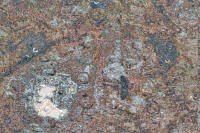
Above: Here’s the
crater named for Jules Verne, from a Clementine
image. The structures on the crater floor are quite
typical of the ones found on the Moon.
There is
every likelihood that a dome once covered the whole
place, which therefore probably is not an impact crater.
The rather
blatant letters “C” and “L” (or maybe "V") can be seen
nearby, and in the larger area there are a few more, but
I think we can probably risk an assumption that they
aren’t really letters.
Even I won’t
propose that some Martian Nostrodamus predicted the
eventual photographing of the site and had it suitably
decorated in honor of the probe. Nor do I think it is
some inside joke- the forms are really there.
I should
note that this is the only crater where I have
personally seen shapes like that, though., so it rates a
mention
.
|
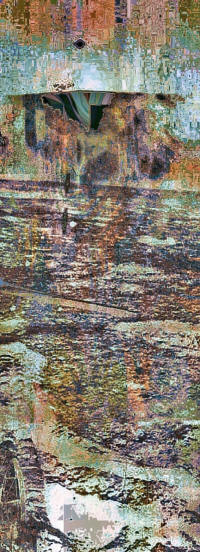 |
Left:
Here’s a view of what every science fiction fan would
expect to see on the Moon- a wildly alien building,
impossibly huge, rising to a staggering height above the
lunar surface.
This picture
was taken by Luna 17, one of a series of robot
tractors sent up by the Soviets. Few of the
images from those missions were made available,
unfortunately.
There are
similarities to the Atlantean architecture, but there
are differences, too.
Some may
say, "If we didn't go, then they didn't go either", but
even the most insistent Apollo critics allow that
automated probes would have played some part in any
hoax. So this is probably the Moon. How about that?
There are giant buildings up there after all.
|
|
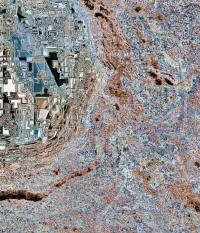
Plato
|
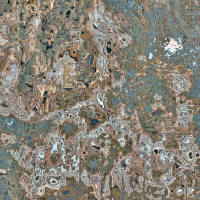
Isis
|
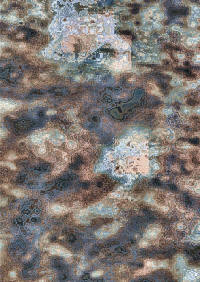
Kepler |
|
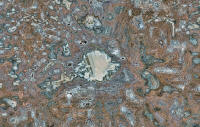
Cleo
|
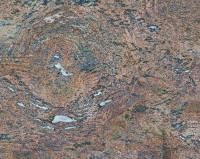
Pythagoras
|
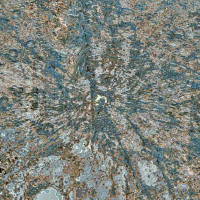
848416230512 |
|







